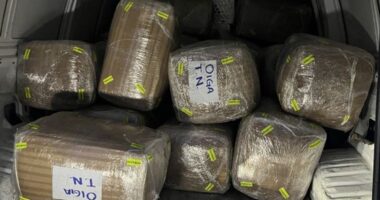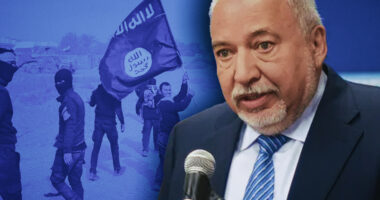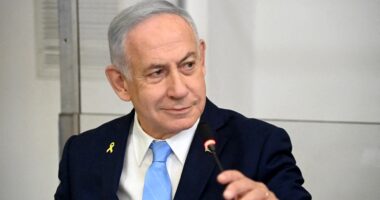News that fresh violence had exploded in Syria last week with a lightning offensive by rebel forces came as somewhat of a surprise to many.
Amid various intense conflicts happening worldwide, such as Israel’s ongoing wars in Gaza and Lebanon, the situation in Syria seemed relatively calm with a fragile ceasefire in place since 2020.
Even though the civil war in Syria seemed to have come to a standstill towards the end of the previous decade, it was never formally resolved, leaving rebel factions in the country actively preparing for a strategic opportunity to resume hostilities.
Shortly after Israel reached a precarious truce with Hezbollah in Lebanon, militant rebel factions from Idlib, a stronghold in northwestern Syria, swiftly launched offensives into the adjacent areas of Aleppo and Hama.
The government troops of longtime Syrian President Bashar al-Assad were swiftly overwhelmed and forced into a rapid retreat, abandoning their positions along with huge quantities of Russian and Iranian-supplied military hardware gleefully seized by the rebels.
Now, the frozen conflict’s explosive thaw has observers and analysts split over what happens next.
For some, this fresh uprising is a spark that will likely be swiftly and brutally quelled. But many others believe this could prove a new chapter in Syria’s torrid history that could finally see Assad’s reign brought to a violent conclusion some 13 years after the first uprisings that triggered civil war.
Here, MailOnline recaps the conflict so far, explains why fighting has emerged anew and explores how the next stage of the saga could pan out.

A view of a vehicle on fire in the aftermath of what the White Helmets say is a strike, in Idlib, Syria, released December 1, 2024

Anti-government fighters pose for a picture on a tank on the road leading to Maaret al-Numan in Syria’s northwestern Idlib province on November 30, 2024

What happened in Syria’s civil war?
The Syrian civil war was sparked in 2011 following the Arab Spring – a wave of pro-democracy uprisings that swept through the Middle East and North Africa sparked by frustration over authoritarian rule, corruption and economic hardship.
Peaceful protests erupted in well over a dozen countries and early success in Tunisia and Egypt encouraged Syrians to try and force the hand of President Bashar al-Assad, who had maintained an iron grip on power since 2000.
But hopes the President would feel the winds of political change and step down were quickly extinguished.
Assad’s regime responded with unequivocal brutality, deploying security forces to ruthlessly suppress dissenters, triggering an explosion of violence which would ultimately devastate huge swathes of the country.
Defectors from the Syrian Armed Forces formed the Free Syrian Army (FSA) and allied with various armed groups to launch a rebellion against the government.
Within a year, the conflict had descended into utter chaos with various factions including secular rebel groups, hardline Islamist groups such as al-Qaeda and even the likes of Islamic State coming into contact with Syrian government forces – either to overthrow Assad or simply seize control of as much territory as possible.
The fight also became yet another proxy conflict.
Seeking to bolster his government forces, a desperate Assad sought help from Russia and Iran along with the latter’s proxies – namely Hezbollah and a patchwork of other armed militias that were whipped into shape by the Islamic Republic’s Revolutionary Guard Corps (IRGC).
Meanwhile, a US-led international coalition meanwhile provided support to select rebel groups, particularly the Syrian Democratic Forces (SDF) – a group of Kurdish fighters that were well supported by Washington and were instrumental in defeating ISIS.
Years of intense warfare followed, though its apex came in 2016 when Russia’s air force along with Syrian government troops and Iranian forces ultimately wrested control of the city of Aleppo out of the hands of the rebels following years of savage bombardments and siege tactics.
By the end of the 2010s, the conflict had reached a stalemate, with Assad’s forces largely regaining control of much of the country. But the human toll was staggering – hundreds of thousands dead and millions displaced.
The rebels retreated to their northwest stronghold of Idlib, and by 2020, a tenuous ceasefire was reached following negotiations led primarily by Russia and Turkey as part of the Astana Process peace talks.
Russia and Turkey agreed to conduct joint military patrols and implement a buffer zone to limit clashes.
Assad meanwhile sought to regain legitimacy regionally, and in May 2023, Syria was re-admitted to the Arab League, signalling recognition of his regime.
But Assad’s forces never managed to regain control of the northwest and the country has been on tenterhooks ever since – a tinderbox ready to ignite anew.

Armed groups opposing Syrian President Bashar al-Assad’s regime seized control of much of Aleppo’s city center in Syria on November 30, 2024

People check the damage at the scene of a Syrian regime airforce strike that targeted a neighbourhood in Syria’s rebel-held northern city of Idlib on December 1, 2024

One Arab newspaper estimated Syrian president Bashar al-Assad’s fortune – largely stolen from his own people – is a staggering £13.5 billion
Why has violence in Syria escalated again – and why now?
On Wednesday, Syrian rebel forces launched a lightning offensive from the northwest, surging out of Idlib province and overwhelming woefully unprepared government troops who are said to have retreated en masse.
This weekend the rebels, spearheaded by Islamist militant organisation Hayat Tahrir al-Sham (HTS), seized full control of the citadel Aleppo city – the capital of the country’s most populous governorate – and are now marching south toward the city of Hama.
That the sudden offensive was launched on Wednesday – hours after Israel and Hezbollah struck their shaky truce – was hardly a coincidence.
In fact, there may never have been a better time for the rebels to go on the attack.
In the early days of the civil war when the rebels’ capabilities were at their peak, Assad’s government forces would never have been able to resist the onslaught were it not for the president’s allies springing to his defence.
Russia contributed massive resources to Syria, with its air force conducting incessant bombing campaigns of rebel positions over the course of several years.
On the ground, Assad’s troops were bolstered by a melange of armed militias – including Hezbollah – that were funded, trained and armed by Iran’s IRGC.
But for nearly three years now, the bulk of Russia’s military resources has been directed toward Ukraine for a war which has proved far more costly – both in economic and human terms – than Vladimir Putin could have ever foreseen.
Moscow still maintains a significant military presence in Syria – the Russian Navy’s only Mediterranean base is located in the port city of Tartus – but has reduced its resources in Syria considerably amid fighting in Ukraine.
Meanwhile, Iran has been preoccupied with Israel’s war against members of its so-called ‘Axis of Resistance’.
Hamas has been crippled by the Israel Defence Forces’ systematic destruction of Gaza and Hezbollah’s capabilities have been reduced dramatically after three months of war in Lebanon.
The Lebanese militant group is now far less likely to be able to dedicate a meaningful quantity of fighters and resources north to support Assad’s troops in attempts to resist the rebel onslaught in Hama.
There is also speculation that HTS was losing internal support, which may have spurred its decision to launch the offensive.
But the favourable security landscape is undoubtedly the primary driver for the timing of the renewed hostilities.

Anti-regime fighters pose for a picture with an army helicopter on the tarmac at the Nayrab military airport in the northern Syrian city of Aleppo on December 2, 2024

A damaged vehicle belonging to the Syrian Government troops, seen in Kafr Halab, Aleppo countryside

Terror group Hayat Tahrir al-Sham is led by Islamist warlord Abu Mohammed al-Jawlani, who has been wanted by the US for over ten years, with a $10 million (£7.9 million) bounty on his head
Who are the key players involved in the fighting?
Hayat Tahrir al-Sham (HTS) and the Syrian National Army (SNA)
HTS, the group leading the rebel offensive in Syria, is a powerful Islamist organisation that has maintained de facto control of Idlib for several years.
The group, led by Abu Mohammad al-Julani, solidified in 2017 as a conglomeration of various Islamist factions but traces its roots to al-Qaeda.
HTS’ core component arose from a group once known as Jabhat al-Nusra – al-Qaeda’s Syrian branch – but later sought to reposition itself as a legitimate Syrian nationalist organisation.
It officially severed ties with al-Qaeda and created a civilian arm known as the ‘Salvation Government’ through which it seeks to govern in Syria, insisting it has no ambition to expand beyond the nation’s borders.
Initial reports from civilians in Aleppo have appeared to suggest that HTS militants have treated inhabitants well after ousting Syrian government forces.
But there are suspicions that HTS’ jihadist origins remain and it is still designated a terrorist organisation by the United Nations Security Council (UNSC), US, UK and the EU, among others.
HTS is largely fighting alongside the Syrian National Army (SNA), which is a coalition of rebel groups supporting what was previously called the Free Syrian Army (FSA) – the group of Syrian defectors that broke off from government forces.
The SNA is quietly supported by Turkey, which is also said to have a cautious agreement with the HTS – though the latter’s jihadist origins prevent it from striking a relationship with Ankara.
Syrian Government/Syrian Armed Forces – and allies
The Syrian Government’s military, the Syrian Armed Forces, is tasked with upholding the regime of President Bashar al-Assad who has remained in power since 2000.
In their efforts to hold off the rebel onslaught following the 2011 uprisings, Assad’s forces displayed ruthless tactics, besieging cities, launching indiscriminate bombing campaigns and even deploying chemical weapons on rebel-held territories.
They were able to maintain control thanks in no small part to the support of Russia, Iran, Hezbollah and militias trained and supported by the IRGC.
As Assad’s forces wilted under the initial rebel onslaught in 2011 and 2012, Iran formed the National Defence Forces (NDF), bringing together Syrian volunteers and foreign fighters into a paramilitary organisation sworn to support the government.
Iran provided substantial support to the NDF, funding its operations, organising heavy weapons shipments and launching a mass recruitment programme that drummed up tens of thousands of troops from Syria, Iran, Iraq, Afghanistan and Pakistan.
The NDF, along with hundreds of other smaller militias, poured into Syria to help Assad’s forces retake territory while the Russian air force bombed the rebels into submission from the air.

Syrian army jets sit on the tarmac the Nayrab military airport in the northern Syrian city of Aleppo on December 2, 2024

Smoke billows in the distance as damaged cars are seen at the site of Syrian regime airstrikes targeting anti-regime fighters in Aleppo, in northern Syria on November 30, 2024

Russian president Vladimir Putin meets with Assad at the Kremlin in Moscow in July
Over the weekend, reports emerged that Iran-aligned militias from Iraq had crossed the border into Syria and were on their way to support Assad’s forces.
There were also confirmed reports of Russian airstrikes in Aleppo and Idlib, but their intensity was disputed.
It remains to be seen how much support Moscow and Tehran are willing to provide Assad, whose regime may very well be dependent on a strong intervention from his allies.
Iran’s Foreign Minister Abbas Araghchi travelled to the Syrian capital Damascus on Sunday to meet Assad, saying before his departure that Tehran would ‘firmly support the Syrian government and army’ but gave no further details.
Kremlin spokesman Dmitry Peskov said Monday morning that Russia would continue to support Assad but added it would ‘form its position based on unfolding events’.
Russia also sacked the man in charge of the Syrian theatre, Lieutenant General Sergey Kisel, suggesting Moscow was displeased with the rebels’ ability to catch Syrian government forces and their Russian allies unawares.
Turkey and Turkish-backed rebel groups
Turkey’s involvement in the conflict in Syria is extremely complex.
Under the hawkish president Recep Tayyip Erdogan, Ankara has sought to support the SNA and other Syrian rebel groups in their fight against both the Assad regime and Islamic extremists.
Erdogan is lending its support to non-jihadist factions he feels could help give Ankara more influence in the neighbouring country.
Turkey has also sheltered the overwhelming majority of the millions of Syrian refugees that fled their home country following the outbreak of war.
Ankara is keen to support rebel groups in seizing and stabilising much of Syria’s north to stem the flow of migrants and subsequently begin deportations of Syrian nationals back across the border.
However, one of Turkey’s primary aims in Syria is to crack down on Kurdish groups which it says are terrorists threatening Turkish sovereignty.
The Kurdistan Workers’ Party (PKK) – a political and militant group of ethnic Kurds – has been fighting the Turkish government for an independent Kurdish state since the 1980s.
Turkey views the PKK and offshoots in Syria – the People’s Protection Units (YPG) and the Democratic Union Party (PYD) – as existential threats and has launched several military operations against them in northern Syria.
But these groups also form the backbone of the Syrian Democratic Forces (SDF), a militant force that has been instrumental in the fight against Islamic extremism and has received US support for doing so.

Syrian White Helmet civil defence worker running in a destroyed neighborhood after the Syrian government forces hit Idlib city, Syria, Monday, Dec. 2, 2024

Anti regime fighters hold a position on the outskirts of the northern Syrian city of Aleppo on November 29
Syrian Democratic Forces (SDF)
The SDF is a multi-ethnic group that controls much of northeast Syria under a de-facto autonomous region known as Rojava.
The group was an instrumental part of America’s efforts to eradicate ISIS in Syria and led the charge on Raqqa – ISIS’ de-facto capital – at the height of the assault on the extremists in 2015.
The biggest and most influential faction of the SDF is the Kurdish YPG – so Turkey is strongly opposed to it and has launched several military operations against it.
Over the weekend, it was reported that the SDF had fought alongside Syrian rebel groups in their assault on Aleppo, but had since struck a deal with rebel leaders to retreat back east.
Meanwhile, Turkish-backed rebels are said to have carried out lightning attacks on areas held by the SDF.
ISIS
The Islamic State was once the most feared jihadist group in the region and played a major role in the Syrian civil war – though in 2024 its presence has been largely eradicated.
ISIS capitalised on the chaos of Syria’s civil war and sought to expand its caliphate.
By 2014 it had managed to conquer huge swathes of Syria and neighbouring Iraq, but before long the radicals began to wilt under consistent offensives by just about every other group involved in the conflict.
The US-backed SDF; a US-led coalition force of more than a dozen countries including the UK, France, Saudi Arabia and Jordan; Turkish-backed groups; Russian forces and even the Syrian government forces all launched their own attacks on ISIS.
Though they were uncoordinated, ISIS was unable to sustain its hold and rapidly began losing territory before its effective defeat in Syria by 2019.
Other factions of the Islamic State are still operating elsewhere and maintain a reasonable amount of territory in East and West Africa, as well as Afghanistan.

An aerial view shows a tank, left behind by regime forces, on the road leading to the Syrian town of Khan Sheikhun, in the northwestern Syrian Idlib province, on December 1, 2024

Residential areas and parked vehicles are damaged following an airstrike by a Su-22 fighter jet belonging to the Bashar al-Assad regime on the city center of Idlib, northwestern Syria, which kills three people, according to initial reports on December 1, 2024

Residential areas and parked vehicles are damaged following an airstrike by a Su-22 fighter jet belonging to the Bashar al-Assad regime on the city center of Idlib, northwestern Syria, which kills three people, according to initial reports on December 2, 2024
How will Assad respond – and what happens if he is toppled?
In the days following the news of HTS’ rapid progress in Aleppo and Hama, there was speculation that Assad had gone into hiding.
The Syrian president issued no address to his nation while Syria’s state-controlled news services did not report on the shocking rebel offensive, prompting critics to claim he had fled to Moscow with his wife and children.
But he is believed to have remained in Damascus and is said to have met Iranian Foreign Minister Abbas Araghchi for consultations in the capital yesterday.
At the weekend, tight-lipped comments made by Assad to various foreign leaders and representatives emerged, though he is yet to make a formal address.
On Sunday, the Syrian President vowed to use force to eliminate ‘terrorism’, state news agency SANA reported, during a phone call with an official from the Moscow-backed breakaway Georgian republic of Abkhazia.
Assad said: ‘Terrorism only understands the language of force, and that is the language which we will break it and eliminate it with, whoever its supporters and sponsors are’, SANA reported.
He later cast the rebel uprising as a ‘foreign-backed terrorist attack’ following consultations with Araghchi, during which the Syrian President reportedly emphasised ‘the importance of the support of allies and friends’ in confronting such attacks.
Based on these limited statements, it seems Assad will fight tooth and nail to retain his grip on power and will work fervently to drum up support from Russia and Iran, without which he would likely be toppled.
This begs the question – what would happen next if rebels do manage to eliminate Assad?
Though the president secured his position with sheer brutality and vile treatment of his own citizens, it is likely that his ousting would trigger utter bedlam in Syria.
Without a common enemy to unite against, the various factions making up the rebel movement would likely turn inward, fighting one another across sectarian and ethnic lines in a fractious battle for power that would only serve to plunge the nation deeper into crisis.
Meanwhile, regional powers – particularly Turkey, Iran, Saudi Arabia and even Israel – could seek to capitalise on the chaos, raising the prospect of yet another proxy war.
Finally, such mayhem could even spark a jihadist resurgence.
In the absence of a cohesive international plan, Syria’s future looks bleak no matter the outcome.

















